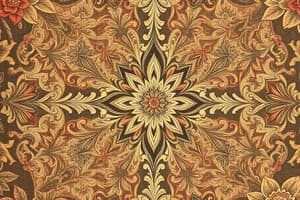Podcast
Questions and Answers
Explain how you can identify and continue a geometric pattern. Provide an example.
Explain how you can identify and continue a geometric pattern. Provide an example.
To identify and continue a geometric pattern, you can look for a constant ratio between consecutive terms. For example, in the sequence 2, 6, 18, 54, the ratio between consecutive terms is 3. Continuing the pattern, the next term would be 54 * 3 = 162.
Describe the steps to create a graph using a table of values. Provide an example.
Describe the steps to create a graph using a table of values. Provide an example.
To create a graph using a table of values, first, list the x-values and corresponding y-values in a table. Then, plot the points on the coordinate plane and connect them to form the graph. For example, if the table of values is (1, 3), (2, 5), (3, 7), the points would be (1, 3), (2, 5), (3, 7) on the graph.
Explain the process of finding the pattern rule for a given number pattern. Provide an example.
Explain the process of finding the pattern rule for a given number pattern. Provide an example.
To find the pattern rule for a given number pattern, analyze the relationship between the terms. This may involve addition, subtraction, multiplication, or division. For example, in the pattern 5, 9, 13, 17, the pattern rule is to add 4 to the previous term. So, the pattern rule is 'add 4'.
What is a pattern in mathematics?
What is a pattern in mathematics?
What is the purpose of a rule in a mathematical pattern?
What is the purpose of a rule in a mathematical pattern?
In the context of pattern recognition, what is the significance of observing a sequence closely?
In the context of pattern recognition, what is the significance of observing a sequence closely?
What is the key characteristic of a mathematical pattern?
What is the key characteristic of a mathematical pattern?
What do math patterns help in finding?
What do math patterns help in finding?
Flashcards are hidden until you start studying
Study Notes
Identifying and Continuing Geometric Patterns
- Geometric patterns involve sequences where each term is obtained by multiplying the previous term by a consistent factor.
- To identify a geometric pattern, look for a common ratio between consecutive terms.
- Example: The sequence 2, 6, 18, 54 shows a geometric pattern where each term is multiplied by 3 (common ratio) to continue the pattern as 162, 486.
Creating a Graph Using a Table of Values
- Begin by determining the variables for the table, typically x and y coordinates.
- Populate the table with pairs of values; for example, x (1, 2, 3) can correspond with y (2, 4, 6).
- Plot each pair on a coordinate plane and connect the points to visualize the relationship.
- Example: The table may show x = 1, 2, 3 with corresponding y = 2, 4, 6, resulting in linear points at (1,2), (2,4), (3,6).
Finding the Pattern Rule for a Given Number Pattern
- Examine the differences between consecutive terms to derive a rule.
- Identify whether the differences are constant (arithmetic) or follow a specific multiplication (geometric).
- Example: For the pattern 5, 10, 15, the difference is consistently 5, indicating a rule of adding 5 to the previous term.
What is a Pattern in Mathematics?
- A pattern in mathematics is a predictable sequence of numbers or shapes that follow a specific rule or relationship.
Purpose of a Rule in a Mathematical Pattern
- A rule provides a systematic way to generate subsequent terms in a pattern, simplifying predictions and calculations.
Significance of Closely Observing a Sequence
- Observing a sequence closely allows for better identification of relationships, repetitions, and rules, enhancing pattern recognition and predictive capabilities.
Key Characteristic of a Mathematical Pattern
- The key characteristic of a mathematical pattern is its reproducibility based on the underlying rule, ensuring consistency across terms.
Uses of Math Patterns
- Math patterns assist in problem-solving, forecasting future values, simplifying complex data analysis, and recognizing relationships in mathematical concepts.
Studying That Suits You
Use AI to generate personalized quizzes and flashcards to suit your learning preferences.




